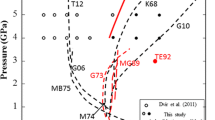Abstract
We conducted fluid-absent partial melting experiments, at 0.5 and 1.0 GPa in the temperature range 750 to 1000 °C, to investigate the influence of bulk rock Mg ? [100Mg/(Mg+Fe)] and the effects of additional TiO2 on the granulite-grade anatectic evolution of relatively magnesian metapelites and metagreywackes. In these experiments, melting began between 780 and 830 °C by the incongruent breakdown of biotite to produce quartz-saturated, granulite-facies residual mineral assemblages in equilibrium with H2O-undersaturated granitic melt. The glass (quenched melt) compositions produced in this study vary little. Generally, the glasses have compositions similar to those of many natural strongly peraluminous leucogranites. The solidus temperatures in both rock types increase with increasing Mg ?, but are unaffected by the presence or absence of a TiO2 component. At 0.5 GPa the metapelites melted at temperatures up to 50 °C lower than the equivalent metagreywackes, but at 1 GPa there was no discernible difference. This study suggests that the fluid-absent solidus has a steep positive dP/dT slope in metapelites and steep negative dP/dT slope in metagreywackes. The pattern of melt production with increasing temperature is strongly controlled by the upper limit of biotite stability. In TiO2-free compositions this was found to increase by 15 to 20 °C in the metapelites and by 30 to 40 °C in the metagreywackes, as a function of increasing Mg ? from 49 to 81. The presence of a TiO2 component increases the upper limit of biotite stability by ∼50 °C in the metapelites and by ∼80 °C in the metagreywackes, over that observed in the equivalent TiO2-free compositions. In consequence, in the TiO2-free samples large pulses of melt (up to 35 wt%) are produced over narrow temperature ranges (as little as 15 °C in these experiments) between 830 and 875 °C. In the TiO2-bearing samples the major pulse of melt production occurs more gradually between 830 and >900 °C.
Similar content being viewed by others
Author information
Authors and Affiliations
Additional information
Received: 15 September 1996 / Accepted: 24 February 1997
Rights and permissions
About this article
Cite this article
Stevens, G., Clemens, J. & Droop, G. Melt production during granulite-facies anatexis: experimental data from “primitive” metasedimentary protoliths. Contrib Mineral Petrol 128, 352–370 (1997). https://doi.org/10.1007/s004100050314
Issue Date:
DOI: https://doi.org/10.1007/s004100050314




